
The new rules for special-purpose acquisitions companies (SPACs) approved last week may further slow down the market for such vehicles and limit their use but SPACs will survive, said Timothy FitzSimons, a partner at King & Spalding.
The Securities and Exchange Commission’s final rules guidance on SPACs and shell companies, approved on Jan. 24, “will make the use of such vehicles more difficult,” but those “committed to this asset class will find a way to operate within the new disclosure regime,” said FitzSimons.
SPACs, a kind of “blank check” company, flooded U.S. equity markets in 2020 and 2021. They raise capital in an initial public offering and use the proceeds to acquire an unidentified operating business. The operating company target merges with the publicly traded SPAC (through a “de-SPAC” transaction) and becomes a listed company.
The market took off in 2020 and 2021 but died down when early-stage companies that used the SPAC vehicle performed poorly in the public markets. Investors and regulators began to question SPAC structures and incentives.
The new regulations, said the SEC, will protect investors because they require SPACs to disclose more information about sponsor compensation, share value dilution risks, and conflicts of interest within SPACs. They also provide additional nonfinancial disclosures about the target private operating company in the de-SPAC transaction.
A change in the liability for disclosures and the requirements for financial projections will make early-stage companies with a short operating history — which frequently used SPAC vehicles in 2020 and 2021 — think twice before merging with a SPAC to go public. “It will be more difficult for those companies to tell a story,” said FitzSimons.
Said SEC Chair Gary Gensler: “The federal securities laws provide a range of protections for investors in traditional IPOs — through disclosure, marketing standards, as well as gatekeeper and issuer obligations. … This adoption will ensure that similar protections apply to investors in these non-traditional IPOs as much as they do for investors in traditional IPOs.”
SPAC sponsors — which initiate the SPAC process and often provide the highest-risk capital — see the regulations as adding time, expense, and risk to the process — “all the things they don’t like,” said FitzSimons, but they also see it as “professionalizing the asset class.”
Because sometimes companies can’t remain exclusively in the private markets or can’t take advantage of the traditional IPO process, it was important for the SPAC path to be preserved, said FitzSimons. In addition, FitzSimons said, “retail shareholders, the proverbial widows and orphans, benefit from a wider class of public companies that they can invest in.”
SEC Commissioner Hester Pierce, who voted against the regulations, said the SEC “could have assisted the market in achieving targeted and clear enhancements to SPAC disclosures without imposing unnecessary costs. ….By layering obligations on the SPAC process, we are effectively taking this option off the table for companies, some of which are likely not to go public at all,” she said.
Last year saw 31 SPAC IPOs raise $3.8 billion, compared with 2021, the height of the market, when 613 SPAC IPOs raised $162 billion.


